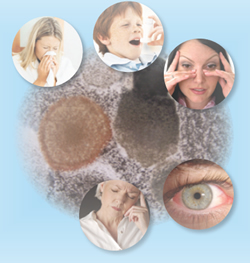
The quantity of mold fragments and spores needed to cause health  problems varies from person to person.
problems varies from person to person.
Recent studies have linked mold to the rapid rise of the asthma rate over the past 20 years.
A 1999 Mayo Clinic study implicates mold/fungus as the cause of almost all chronic sinusitis of the afflicting 37 million Americans.
Contact your doctor if you have concerns regarding your health due to mold exposure.
Q: Can I use Bleach to kill mold?
A: Beach is 3-6% sodium hypochlorite and 94% to 97% water. The sodium hypochlorite evaporates, leaving water behind to foster the growth of more mold. The Clorox® Company, OSHA, and the EPA all have determined that bleach should not be used in mold remediation. Bleach is ineffective and unsafe for cleaning or killing mold.
Q: What types of mold are “toxic” and what types of mold are “safe”? Are there “safe” mold levels?
A: All molds are allergens and can degrade indoor air quality. Thus, whether or not a mold has toxic properties is irrelevant for mold assessment and remediation.
Q: Why is mold a problem now?
A: During the energy crisis in the 1970’s, a strong trend began to make buildings more energy efficient. This created buildings with little outside air exchange and more dependent on the air conditioner system.



JOIN US SOCIALLY